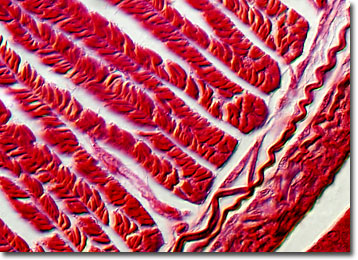Differential Interference Contrast Image Gallery
Earthworm Muscle Tissue
According to folklore, earthworms have been seen falling from the sky with rain. Though such an occurrence is unlikely, it is easy to understand how such a myth originated, since earthworms often venture out of their burrows after a storm to find mates because their mobility is much better on damp ground.

Earthworms vary in length depending upon species and belong to the phylum Annelida, which contains the segmented worms. The common earthworm Lumbricus terrestris, known as the night crawler in the United States, rarely exceeds lengths of more than ten inches. However, some tropical species of earthworm can be up to eleven feet long. In order to move such long, tapered bodies forward, earthworms exhibit peristalsis, a wave-like motion achieved through rhythmic muscular contractions. With the additional aid of the setae that line each of their body segments, earthworms are relatively adept at wriggling their way through the soil and across the ground.
Even though they have no prominent sensory organs, earthworms are sensitive to vibrations and variations in light. During daylight hours, they generally remain underground where they burrow through the soil, consuming organic material. If they need to find additional food, a mate, or a better area in which to live, they typically will emerge at night in order to avoid the blaring heat of the sun. The daily movements and eating habits of earthworms provide an important agricultural service since they help to aerate and mix soil.
